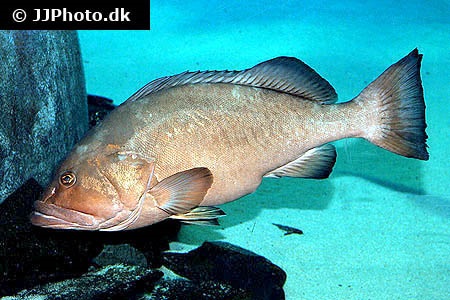Epinephelus marginatus

| Latin name | Epinephelus marginatus |
|---|---|
| Local name | Dusky grouper |
| Family | Serranidae - Epinephelus |
| Origin | East Indian Ocean, West Indian Ocean, West Atlantic, Mediterranean Sea |
| Max length | 150 cm (59.1") |
| Minimum volume | Unknown |
|---|---|
| Hardiness |
Hardy |
| Suitable for aquarium |
Unknown |
| Reef safe |
Reef safe with caution |
| Aggressiveness | Unknown |
| Recommended |
Fish Larger crustaceans (Shrimp, crabs...) |
|---|
This species is endangered.
This species grows very quickly if fed well.
This species eats all kinds of fish, shrimps, crabs etc. which are of suitable size.
There is little available knowledge of this species, so there can be important information missing on this page.
This species needs a very large aquarium when fully grown.
Exactly how big the aquarium should be is hard to say, but the size of this species is such, that it cannot normally be kept in a home aquarium.
This species can change gender from female to male.
When a male is needed, a female changes sex and takes on the role.
The Sea Bass family (Serranidae) spans a broad spectrum with regards to how suitable they are to aquaria, as some are best suited to specialist or larger aquaria, while other are often seen in reef aquaria.
Below are described the five subfamilies one sees most often in aquaria. There are however other species one can also keep under the right circumstances, but these are for the most, large predatory fish.
Anthias (Anthiinae)
The Anthias species spans over many different genera, but the most common is the Pseudanthias genus. They mostly have an attractive orange or pink shade.
They are generally all reef safe and peaceful.
There is however a large difference to their food requirements, some species demand constant feeding, whereas others can get used to being fed once a day.
The easiest species are the following: P. bartelettorum, Anthias, Luzonichthys, Nemanthias, Odontanthias, Pseudanthias, Sacura and Serranocirrhitus
Liopropomatinae
This subfamily encompasses some of the smallest fish in the Serranidae family, they can be very colourful but shy. The Liopropoma genus encompasses many species which are suitable for aquaria, however they normally thrive best in a very peaceful- or nano aquarium.
Grouper (Epinephelinae)
These fish grow typically too large for most home aquaria. There are however some species that do lend themselves to the slightly bigger domestic aquarium. Several of the species look very impressive and often have a interesting personality, and they often recognize the aquarist and will become tame over time.
Groupers are predatory fish and eat everything they can swallow; fish, crabs, shrimps and sometimes other invertebrates. Like most large predatory fish they excrete a lot of nutrients to the water, so one therefore needs a good filter system.
Groupers include among others the following genera: Aethaloperca, Cephalopholis, Chromileptes, Epinephelus, Paranthias and Pogonoperca
Soapfishes (Grammistinae)
These fish are like the Groupers predatory fish, but they do not typically, grow so large. They are relatively hardy, but some of the species demand a thorough preperation if one wants to be successful.
Soapfishes are generally very shy and will often hide under an overhang during the day, and hunt at night.
Soapfishes include among others the genera: Grammistes
Serraninae
The most common genera in captivity is Dwarf Seabasses (Serranus) and Hamlets (Hypoplectrus).
See the description of the individual genera below.
Scott W. Michael. 2001. Basslets, Dottybacks & Hawkfishes: v. 2 (Reef Fishes) - TFH Publications / Microcosm Ltd. - (English)
Bob Fenner. Basses of the Genus Epinephelus - Wet Web Media - (English)
WWM Crew. FAQs about Basses of the Genus Epinephelus - Wet Web Media - (English)
Bob Fenner. The Basses, Family Serranidae - Wet Web Media - (English)

